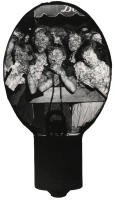Documentary photojournalism flourished in the mid-twentieth century. Its popularity was nourished by the invention of the handheld camera, access to and improvement of photographic resources, and advances in printed media production and civilian travel. Photographers embarked on journeys to explore the world. Some investigated their own hometowns and families, others took to roadways, boats, and planes to explore the expanses of their own, as well as foreign, countries. The images they made were reproduced in newspapers and magazines, such as LIFE and Time. They told stories which, depending on the viewer, showed something familiar or something completely new. The photographs offered a vision of the world that encouraged interest in the experiences of those portrayed.
These five images show different ways that photographers from this era approached their subjects. They were shot on black and white analog film and printed with the gelatin silver process. While the treatment of the film itself is similar, the treatment of the subjects is quite different. Date, image title, camera angle, and the use of specific names and places offers context for the images. The images show complexity of interaction and environment within the family setting, particularly within the environment of both preparation and consumption of food.
Russell Lee, Negro family in crowded quarters, April 1941 (17.2003)
The image titles offer insight into the intention of the photograph and the perspective of the photographer but they do not necessarily determine meaning given to the image by the viewer. Negro family living in crowded quarters, 1941, by Russell Lee shows four family members sitting together in a tenement kitchen in Chicago. They represent unity in the face of challenge. Their kitchen may be small, but they have each other. Lee’s interpretation of his subjects is less benevolent as we can gather by the offhand general terms in which they’re described.
W. Eugene Smith, Family Dinner–the Curiels eat thick bean and potato soup from common pot on dirt floor of their kitchen. The father, mother and four children all share the one bedroom, 1950 (1563.2005)
In W. Eugene Smith’s image, the title from LIFE actually describes the subject’s economic circumstances with words. The title seems to negatively highlight their circumstances. Again, this photograph can be viewed as a representation of unity in the small domestic space.
Leonard McCombe, Family dinner at the Novaks’ in Chicago is joined by Kim who stopped off for a rushed visit on her way east, 1956 (1101.2005)
Leonard McCombe’s image shows Kim Novak, a prominent Hollywood actress, eating with guests in her home. It was taken only five years after the image made by Smith. The guests enjoy the luxury of fine china and sit below framed by portraits of the actress. Novak is holding her hand in a claw-like shape and the room seems equally as cramped, only in this case, the people are also surrounded by expensive objects and physically trapped by their presence.
Bruce Davidson, [Family at kitchen table, New York], from the East 110th Street series, 1966
This image by Bruce Davidson shows a family is clustered very closely together at their table in a New York kitchen. The kitchen is small but revealing of a strong culture and connection between generations. Small details such as the plants, bird, clock, flowered tablecloth, and bells on the door show the care that this family put into their modest but considered space.
Shelby Lee Adams, The Childer’s Kitchen, 1986 (636.1994)
The Childer’s Kitchen, 1986, by Shelby Lee Adams is the most recent of all the images here. Adams is familiar with his environment and is photographing people from his own social community. It’s obvious from his style and approach that he’s not making a generalized statement about people whom he photographs. By using specific names in the title of the image, Adams shows respect for his subjects.
Looking back on photojournalistic photography after almost a century of its birth can pose both new challenges as well as lead to new insights into the methods and intentions of these photographers and the media that reproduced their works. As time progressed, the photographers shown here approached their subjects with a less-biased position. This collection, while varying in approach, shows that the domestic environment that surrounds the kitchen and food is a window into the circumstances not only of each family or individual, but of the time and place where the image was made. Regardless of the photographer’s intention, we as viewers are now able to look at these images and give unique meaning to the stories that we see.
–Winona Barton-Ballentine, ICP-Bard 2013






